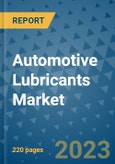Market Insights
Automotive lubricants are essential for ensuring smooth vehicle operation, reducing friction, and improving performance efficiency. The global market is witnessing significant transformation as automakers and lubricant manufacturers focus on sustainability and extended drain intervals. Synthetic and semi-synthetic lubricants are gaining traction due to superior stability, thermal resistance, and environmental benefits compared to conventional oils.The rising production of passenger and commercial vehicles, coupled with growing aftermarket service networks, continues to drive lubricant consumption worldwide. Additionally, the development of low-viscosity and bio-based lubricants aligns with global efforts toward carbon reduction and fuel economy enhancement.
Key Market Drivers
- Rising Vehicle Parc and Maintenance Demand
- Technological Advancements in Engine Design
- Shift Toward Synthetic and Semi-Synthetic Oils
- Regulatory Push for Eco-Friendly Solutions
- Aftermarket Expansion and Service Integration
Business Opportunity
Emerging economies present a vast opportunity for market participants as motorization rates continue to rise. Nations such as India, Indonesia, Brazil, and Nigeria are experiencing robust vehicle demand, thereby fueling lubricant consumption. Additionally, as electric vehicle (EV) penetration grows, specialized lubricants such as thermal management fluids and EV gear oils are creating a new product niche.Manufacturers are also leveraging digitalization, IoT-based monitoring, and predictive maintenance tools to optimize lubricant performance. Partnerships between automakers and lubricant companies to co-develop tailored solutions for next-generation vehicles will further enhance competitive differentiation.
The market’s shift toward circular economy principles - focused on re-refining used oils and recycling packaging - presents additional sustainability-linked business avenues.
Regional Analysis
Asia Pacific dominates the global automotive lubricants landscape, supported by massive vehicle production in China, India, and Japan. The region benefits from expanding automotive manufacturing clusters and growing aftermarket demand.North America continues to show steady growth, driven by a mature vehicle fleet, strong focus on performance-enhancing lubricants, and rapid penetration of synthetic oils.
Europe exhibits a transition toward eco-friendly and low-viscosity lubricants aligned with strict emissions standards and the EU Green Deal.
Latin America is witnessing rising demand due to increasing vehicle ownership and industrial recovery, while the Middle East & Africa markets grow steadily with expanding logistics and commercial fleets.
Key Players
The global automotive lubricants sector is characterized by the presence of leading multinational and regional companies focusing on technological innovation, brand partnerships, and sustainable product development. Prominent players include:Shell
Exxon Mobil
Castrol
BP plc
Repsol
LUKOIL
Sasol
TotalEnergies SE
Indian Oil Corporation Ltd
HP Lubricants
Philipps 66
Fuchs
Cepsa
These companies are expanding production capacities, launching low-viscosity oils, and introducing high-performance synthetic blends to strengthen their global footprint. Strategic collaborations with OEMs, coupled with investments in EV-compatible lubricants, remain key growth strategies.Global Automotive Lubricants Market Segmentation
By Product Type
Engine Oil
Gear Oil
Transmission Fluids
Brake Fluids
Coolants
Greases
By Oil Type
Synthetic
Semi-synthetic
By Region
North America
Europe
Asia Pacific
Latin America
Middle East & Africa
This product will be delivered within 1-3 business days.
Table of Contents
Companies Mentioned
Some of the companies profiled in this Automotive Lubricants market report include:- Shell
- Exxon Mobil
- Castrol
- BP PLC
- Repsol
- LUKOIL
- Sasol
- TotalEnergies SE
- Indian Oil Corporation Ltd
- HP Lubricants
- Philipps 66
- Fuchs
- Cepsa








